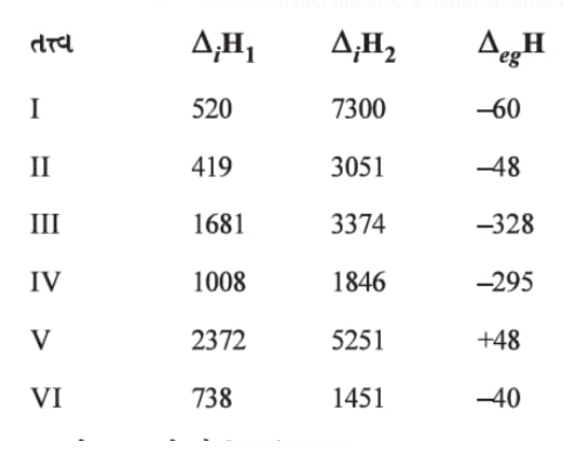કેટલાક તત્ત્વોની પ્રથમ (ΔiH1) અને દ્વિતીય (ΔiH2) આયનીકરણ એન્થાલ્પીના મૂલ્યો (kJmol−1માં ) અને ઇલેક્ટ્રૉન પ્રાપ્તિ એન્થાલ્પી (ΔegH) ના મૂલ્યો (KJmol−1 માં ) નીચે આપેલા છે :
 ઉપર જણાવેલા તત્ત્વો પૈકી કયું તત્ત્વ :સૌથી ઓછું પ્રતિક્રિયાત્મક તત્ત્વ છે ?
ઉપર જણાવેલા તત્ત્વો પૈકી કયું તત્ત્વ :સૌથી ઓછું પ્રતિક્રિયાત્મક તત્ત્વ છે ?
Step by step video & image solution for કેટલાક તત્ત્વોની પ્રથમ (Delta_iH_1) અને દ્વિતીય (Delta_iH_2) આયનીકરણ એન્થાલ્પીના મૂલ્યો (kJ mol^(-1)માં ) અને ઇલેક્ટ્રૉન પ્રાપ્તિ એન્થાલ્પી (Delta_(eg)H) ના મૂલ્યો (KJ mol^(-1) માં ) નીચે આપેલા છે : ઉપર જણાવેલા તત્ત્વો પૈકી કયું તત્ત્વ :સૌથી ઓછું પ્રતિક્રિયાત્મક તત્ત્વ છે ? by Chemistry experts to help you in doubts & scoring excellent marks in Class 11 exams.
Updated on:21/07/2023Topper's Solved these Questions
Similar Questions
નીચે દર્શાવેલા સંયોજનોમાં પ્રત્યેક કાર્બન કયું સંકરણ ધરાવે છે ? CH3Cl
View Solutionએક બલૂન ( ફુગ્ગો ) માં હાઇડ્રોજન ઓરડાના તાપમાને ભરવામાં આવેલ છે . જો 0.2 bar દબાણ વધે તો તે ફાટી જાય તેમ છે . જો 1 bar દબાણે વાયુ 2.27 L કદ ધરાવે છે , તો કેટલા કદ સુધી બલૂનને વિસ્તારી શકાશે ?
View SolutionCalculate the resonance energy of gaseous benzene form the following data.
BE(C−H)=416.3kJmol−1
BE(C−C)=331.4kJmol−1
BE(C=C)=591.1kJmol−1
ΔsubHΘ(C,graphite)=718.4kJmol−1
ΔdissHΘ(H2,g)=435.9kJmol−1
ΔfHΘ(benzene,g)=82.9kJmol−1
View SolutionFind DeltaH of the process NaOH(s) rarr NaOH(g) Given: Delta_(diss)H^(Theta)of O_(2) = 151 kJ mol^(-1) Delta_(diss)H^(Theta) of H_(2) = 435 kJ mol^(-1) Delta_(diss)H^(Theta) of O-H = 465 kJ mol^(-1) Delta_(diss)H^(Theta) of Na -O = 255 kJ mol^(-1) Delta_(soln)H^(Theta)of NaOH = - 46 kJ mol^(-1) Delta_(f)H^(Theta) of NaOH(s) =- 427 kJ mol^(-1) Delta_("sub")H^(Theta) of Na(s) = 109 kJ mol^(-1)
View SolutionGiven the bond energies of H−H and Cl−Cl are 430kJmol−1 and 240kJmol−1, respectively, and ΔfH∘ for HCl is −90kJmol−1. Bond enthalpy of HCl is
View SolutionThe first (ΔIH1) and second (ΔIH2) ionisation enthalpies (in kJ mol−1) and the (ΔegH) electron gain enthalpy (in kJ mol−1) of a few elements are given below:

The least reactive element is :
View SolutionCalculate ΔH for the process at 25∘C of dissolving 1.0 mol of KCI in a large excess of water..
ΔfH∘[K+(aq)]=−251.2kJmol−1
ΔfH∘[Cl−(aq)]=−167.08kJmol−1
ΔfH∘[KCl]=−437.6kJmol−1 .
View SolutionGiven that the bond energies of H - H and CI - CI are 430 kJ "mol"^(-1) and 240 kJ "mol"^(-1) respectively and Delta_(f)H for HCI is -90 kJ "mol"^(-1) , bond enthalpy of HCI is
View SolutionGiven that bond energies H-H and Cl-Cl are 430kJmol−1and240kJmol−1 respecively and ΔfH for HCl is −90kJmol−1. Bond enthalpy of HCl is :
View SolutionGiven the bond energies of H−H and Cl−Cl are 430kJmol−1 and 240kJmol−1, respectively, and ΔfH∘ for HCl is −90kJmol−1. Bond enthalpy of HCl is
View SolutionFind ΔH of the process
NaOH(s)→NaOH(g)
Given: ΔdissHΘofO2=151kJmol−1
ΔdissHΘofH2=435kJmol−1
ΔdissHΘofO−H=465kJmol−1
ΔdissHΘofNa−O=255kJmol−1
ΔsolnHΘofNaOH=−46kJmol−1
ΔfHΘofNaOH(s)=−427kJmol−1
ΔsubHΘofNa(s)=109kJmol−1
View Solutionએક વિદ્યુત ઈસ્ત્રી મહત્તમ દરથી ગરમ થાય છે ત્યારે 840 Wના દરથી ઊર્જા વાપરે છે અને લધુત્તમ દરથી ગરમ થાય છે ત્યારે 360 Wના દરથી ઊર્જા વાપરે છે. વોલ્ટેજ 220 V છે. દરેક કિસ્સામાં વિદ્યુતપ્રવાહ અને અવરોધ કેટલા હશે ?
View Solutionનીચે આપેલ પૈકી કઈ પરિસ્થિતિમાં અંતર્ગોળ અરીસો કોઈ વસ્તુનું વસ્તુ કરતા મોટું અને વાસ્તવિક પ્રતિબિંબ રચે છે ?
View Solutionનીચે આપેલ પૈકી કયું વિધાન સત્ય છે?
View Solutionતમને પાણી, સરસવનું તેલ, ગ્લિસરીન અને કેરોસીન આપેલ છે. આ પૈકી કયા માધ્યમમાં સમાન કોણથી આપાત થયેલ ત્રાંસું પ્રકાશનું કિરણ સૌથી વધુ વાંકું વળશે ?
View Solutionનીચે આપેલ પૈકી કોના દ્વારા અનંત અંતરે મૂકેલ વસ્તુનું અત્યંત નાનું અને બિંદુવત્ પ્રતિબિંબ મળે છે ?
View Solution
